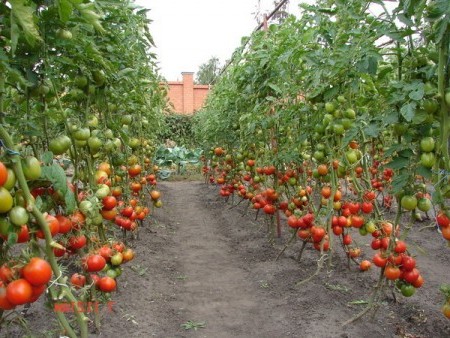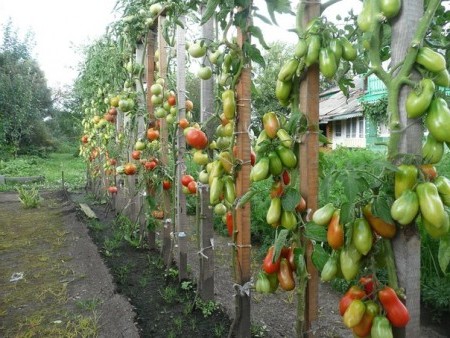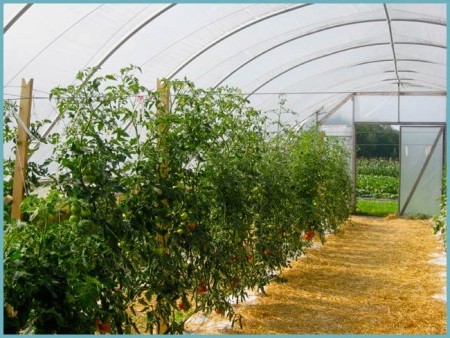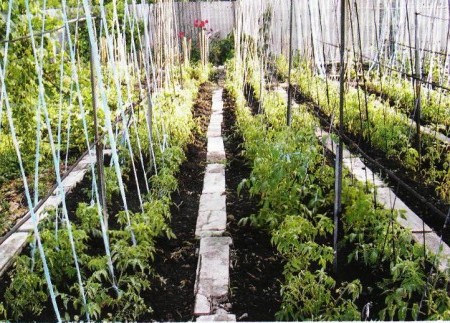Many summer residents are beginning to switch to growing tall tomatoes. The peculiarity of indeterminate tomatoes to continuously grow and the ability to form flower clusters in unlimited quantities is, of course, captivating. But growing tall tomatoes has its own difficulties.
- In the garden bed where indents will be cultivated, you need to build a trellis and constantly tie up the rapidly growing shoots.
- To get an earlier harvest, accelerated tomatoes need to be formed into one to three stems. Constant “surgical intervention” makes indeterminate tomatoes more vulnerable (if we compare them with determinate tomatoes grown without shaping and garter) to viral diseases.
Although it is not entirely correct to call these disadvantages of tall tomatoes, rather, these are the risks that one has to face when growing them. By the way, tall tomatoes are not always grown on a trellis and not all summer residents are engaged in their formation. If there is enough space on the plot, the tomato shoots are allowed to “float freely”, only occasionally directing them from the irrigation furrows into the dry aisles.
In the southern regions, even without shaping, such tomatoes grow well and manage to form and “nourish” a decent number of fruits to a ripe state. At the end of summer, summer residents harvest tomato plants growing without formation almost at the very top of the trellis. And on the eve of frost, they stock up on a lot of green fruits, which gradually ripen at home, thereby extending the tomato season by a month, or even all three.
The yield of indeterminate tomatoes is much higher than that of determinate ones. And they produce their harvest not in one or two stages, like the low-growing ones, which “burn out” already in August, but over a long period of time - all summer and autumn, right up to the first frost, and in a greenhouse - even longer.
Naturally, a large vegetative mass of plants and yield load require more intensive agricultural technology. But the gain in yield justifies the cost of installing trellises and increased fertilizer rates. Especially when there are no extra square meters on the site.It’s not for nothing that summer residents in greenhouses abandoned growing low-growing tomatoes in favor of indents.
It should also be mentioned that indeterminate plants create more favorable conditions for the formation of high-quality fruits. Uniform illumination and good ventilation do not create conditions for the development of fungal diseases. And if diseases do appear, it is easier to treat plants on a trellis with pesticides. With a trellis culture, the fruits do not come into contact with the ground, and therefore do not rot, and are less affected by the cotton bollworm, slugs, and mice.
For dacha aesthetes, it is also important that the trellis with healthy tomato plants tied up in time looks like a neat green wall, decorated with green and ripe fruits, which can be not only red, but also yellow, pink, not only round, but also pear-shaped, plum-shaped, cherry-like.
I think everything is clear about the pros and risks of growing indeterminate tomatoes. Let's move directly to the agricultural technology of their cultivation.
Growing tall tomatoes:
How to grow tall tomato seedlings
Growing seedlings of indeterminate tomatoes is not much different from growing low-growing seedlings or medium-sized tomatoes. Unless the seeds are sown 10-12 days earlier. But you shouldn’t start sowing already in February; it’s enough to sow indent seeds in mid-March.
The soil mixture is prepared from equal parts of turf, humus soil and peat, adding a teaspoon of superphosphate, potassium sulfate and urea for every ten liters.You can sow in a seedling box so that at the stage of 1-2 true leaves you can plant them in cups, but it is better to sow in small cassettes with a retractable bottom, so that later, when the roots of the seedlings have mastered the soil ball, you can painlessly transfer the seedlings into more spacious containers.
It is better to sacrifice quantity for the sake of the quality of seedlings and grow, for example, not twenty roots in 200-gram cups, but ten in liter ones. Plants that begin their life in cramped conditions will not be pleased with high yields.
What should be the temperature when growing seedlings?
The optimal temperature for seed germination is +23 +25 degrees. After sowing the seeds, the seedling box or cassette block is covered with a film, which is removed immediately after the first shoots appear.
In the first half of the seedling period, the temperature should be approximately the same - +23 +24 degrees. A month after sowing, it is advisable to reduce the temperature by 1-2 degrees (increase ventilation). Two weeks before planting in open ground, the temperature is reduced to 19 degrees. This can be done by moving the seedlings to a loggia, balcony, veranda. It is not worth keeping seedlings in the cold for a long time: low temperatures inhibit the development of seedlings and contribute to the fact that the first cluster is planted too low.
How to feed seedlings
Seedlings need feeding even more than adult plants. The seedlings are fed for the first time about a week after picking. You can infuse humus that was prepared for the seedling mixture (1 part humus to 10 parts water).
A week later, the second feeding: 0.5 teaspoon of urea, tbsp. a spoonful of superphosphate, a teaspoon of potassium sulfate per 5 liters of water.Superphosphate is diluted with water a day before feeding. It is not at all necessary to use these recommendations. There is now a large selection of fertilizers on sale that will provide seedlings with balanced nutrition. They contain not only phosphorus, nitrogen, potassium, but also microelements necessary for the proper development of plants. And using such fertilizers is simple: you just need to follow the instructions.
By the time of planting in open ground, seedlings of indeterminate tomatoes should have 9-10 true leaves and a flower raceme with an average length of internodes of 5-7 cm.
Planting seedlings in the garden
The soil for tomatoes is prepared in advance. The best predecessors for them in the garden are considered to be cabbage and cucumbers, to which high doses of fertilizers were applied. Tomatoes grow well after peas, beans, zucchini, corn, and after green manure (rye, winter wheat). The predecessors of tomatoes cannot be nightshade crops (peppers, eggplants, potatoes, physalis). It is not recommended to plant tomatoes next to potatoes, so as not to promote mutual infection with fungal and viral diseases.
If areas are allocated for tomatoes where onions and root crops were previously grown, organic matter (compost, humus - up to a bucket) is added for autumn digging, 2 tbsp. spoons of superphosphate, tbsp. spoon of potassium sulfate per sq. m.
Fertilizers applied for autumn digging will be used by plants in the late period. In the meantime, while the plants’ root systems are not sufficiently developed, they will “consume” the fertilizers added to the planting holes during the first feeding. It is more rational to apply fertilizers directly into each hole when planting: 0.5 liters of humus or compost, a teaspoon of urea and potassium sulfate, 2 teaspoons of superphosphate.
Seedlings are planted in open ground every 50-55 cm in a row. Rows are spaced 70 cm apart from rows. Seedlings are first planted in a furrow so that for the first time, while the plants are taking root, it is easier to provide them with moisture. After several hillings, which are carried out after watering, the grown plants are no longer in the furrow, but on the ridge. In this position, their stems, even after heavy watering along the furrows, always remain dry. This is very important for the prevention of fungal diseases.
Formation of tall tomatoes into two stems:
How to water tomatoes correctly
Water indeterminate tomatoes in the same way as determinate ones: just at the root trying to prevent water from getting on the leaves and stems. In beds where plants are hilled up and watering furrows are made, these rules are easy to follow. The water should be warm.
For indents, especially large-fruited varieties and hybrids, regular watering is important. Once you don’t water it on time, the fruits become smaller and crack.
Mulching helps to avoid sudden changes in soil moisture. For tall tomatoes grown on a trellis, this agricultural technique is especially important. Plants on a trellis do not shade the soil throughout the day; it overheats and quickly loses moisture. A layer of compost or grass on the surface of the bed eliminates this problem.
The soil in the root zone should be constantly moderately moist. It is not difficult to determine that the roots are neither too dry nor too wet. Let's dig with a shovel to a depth of 10-15 cm, take a little earth and squeeze it in a fist. Having unclenched our fist, we make a decision: if the lump has retained its shape, there is enough moisture and you can hold off on watering, if it has crumbled, it’s time to water.
Tomatoes are watered taking into account the weather and the phase of plant development.For example, if the seedlings were grown in separate containers and their roots were practically not disturbed during transplantation, post-planting watering will be enough for the plants for several days. If the seedlings were planted with a damaged root system (from a seedling box), for the first 5-7 days, the plants are watered so that the soil is constantly moist. After the seedlings take root, frequent watering is abandoned, forcing the plants to develop roots deeper. Plants that were watered moderately during the initial growing season, having developed a deep root system, can more easily tolerate hot weather.
Mature plants require more water, especially since the temperature of the soil and air increases significantly by mid-summer.
During the period of fruit ripening Indents do not reduce watering, since they constantly bloom and set fruit.
Feeding tall tomatoes
Tall tomatoes are fed at least three times a season, using organic infusions (mullein - 1:10, chicken manure - 1:20), and mineral fertilizers.
- The first time they are fed 10-12 days after planting the seedlings in the garden bed, during the flowering period of the first cluster. For 10 liters of water, take 1 liter of organic infusion, add superphosphate extract made from one and a half tablespoons of fertilizer. And again, a clarification: you can use other fertilizers for fertilizing, preferably complex water-soluble ones, designed to nourish plants during the growing season. We combine fertilizing with watering and then mulch the rows with compost or humus so that the soil does not dry out longer and does not overheat.
- During the period of fruit set on the second cluster, we apply a second feeding: 10 liters of organic infusion + tbsp. spoon of complete fertilizer. Consumption - 2 liters per plant.
- We feed the tomatoes with a fertilizer solution of the same composition for the third time - during the period of collecting the first fruits, increasing the consumption rate: 2.5 liters of solution per plant.
If tomatoes are actively growing but bloom poorly, you should abandon nitrogen in fertilizing and increase the dose of phosphorus fertilizers.
Both the standards and the list of fertilizers that are used to feed tomatoes cannot be considered mandatory. Some summer residents prefer to feed the plants in the garden only with organic matter, others have long believed in the power of regular mineral fertilizing according to the D. Mittlider system, others prefer to use “specialized” fertilizers for tomatoes...
Feeding tomatoes, be sure to take into account the fertility of the soil, its structure, and the condition of the plants.
Trellis for indeterminate tomatoes
It is better to install a trellis for indeterminate tomatoes before planting the seedlings, so that the first garter of the plants can be carried out immediately after planting. Trellis are usually made slightly higher than two meters. It is simply inconvenient to tie up shoots at great heights (do not drag a ladder along the beds!). When the plants reach the top wire, the shoots are simply allowed to hang down freely.
Summer residents tie up tomatoes in different ways. When formed into one or three stems, they are tied to vertically stretched ropes. Someone is pulling between trellis supports plastic mesh. Someone ties the stems to a wire stretched horizontally in several rows (the first one is about 30 cm from the ground). Someone drives long stakes next to each plant.
In greenhouses, indeterminate tomatoes are mainly grown in a single stem to provide good light and ventilation to the plants and achieve earlier harvests.In open ground, tall tomatoes are given more freedom and not only the main stem is left. But it is also impossible not to form indents at all: you can get a lot of green mass to the detriment of fruiting, because they are capable of driving stepsons from each leaf axil, and well-fed plants - even two from one.
A lot of green mass to the detriment of flowering and fruiting is not the best option, so you will have to normalize the number of stepsons. In addition to the main stem, you can form two more - from the lower stepsons, which begin to grow under the first flower cluster, and break out the rest once or twice a week. It is better to do this in the morning in sunny weather so that the wounds dry out faster.
If you have not yet decided which variety of indeterminate tomatoes to plant in your dacha, then you can go via this link. The proposed article publishes a large catalog of tall tomatoes for growing both in greenhouses and in open ground. You will definitely find something interesting for yourself.
Continuation of the topic:
- How to grow Oxheart tomatoes
- Tomato growing technology
- The best varieties of pink tomatoes
- How to properly feed tomatoes
- Formation of tomato bushes in a greenhouse and exhaust gas






 (9 ratings, average: 4,56 out of 5)
(9 ratings, average: 4,56 out of 5) CUCUMBERS NEVER GET SICK, I'VE BEEN USING ONLY THIS FOR 40 YEARS! I SHARE A SECRET WITH YOU, CUCUMBERS ARE LIKE THE PICTURE!
CUCUMBERS NEVER GET SICK, I'VE BEEN USING ONLY THIS FOR 40 YEARS! I SHARE A SECRET WITH YOU, CUCUMBERS ARE LIKE THE PICTURE! You can dig a bucket of potatoes from each bush. Do you think these are fairy tales? Watch the video
You can dig a bucket of potatoes from each bush. Do you think these are fairy tales? Watch the video
 How our fellow gardeners work in Korea. There is a lot to learn and just fun to watch.
How our fellow gardeners work in Korea. There is a lot to learn and just fun to watch. Eye trainer. The author claims that with daily viewing, vision is restored. They don't charge money for views.
Eye trainer. The author claims that with daily viewing, vision is restored. They don't charge money for views. A 3-ingredient cake recipe in 30 minutes is better than Napoleon. Simple and very tasty.
A 3-ingredient cake recipe in 30 minutes is better than Napoleon. Simple and very tasty. Therapeutic exercises for cervical osteochondrosis. A complete set of exercises.
Therapeutic exercises for cervical osteochondrosis. A complete set of exercises. Which indoor plants match your zodiac sign?
Which indoor plants match your zodiac sign? What about them? Excursion to German dachas.
What about them? Excursion to German dachas.
Such varieties, in a suitable climate, can grow for more than a year, reach 2-3 meters in height and produce up to 50 bunches of tomatoes.